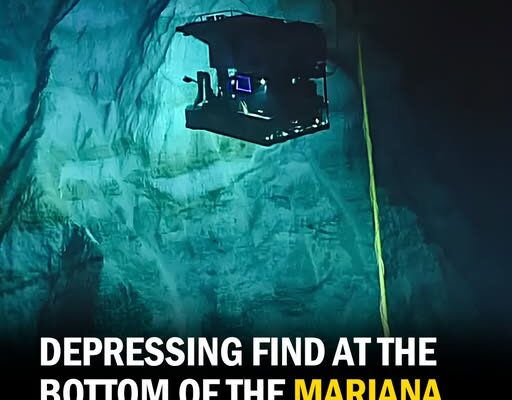The Depths of the Mariana Trench: A Stark Reminder of Plastic Pollution
The Mariana Trench, often regarded as the deepest part of our oceans, has long been thought of as an untouched sanctuary, far removed from the contamination brought on by human activities. However, recent explorations have shattered this myth, revealing a disturbing reality: plastic pollution has infiltrated even the abyssal plains of this remarkable trench. Among the shocking finds is the discovery of a plastic bag, which serves as a stark illustration of the far-reaching consequences of our reckless habits concerning plastic consumption and disposal. This article aims to delve deeper into this alarming revelation, examining its implications for our planet and the fragile marine ecosystems that inhabit it.
Despite its seemingly desolate nature, the Mariana Trench is home to a rich tapestry of life. Remarkable marine organisms, including unique species of coral, jellyfish, and octopus, thrive in these dark depths. Recent studies have highlighted a harrowing statistic: a staggering 17 percent of the images cataloged in the Deep-Sea Debris Database depicted interactions between marine life and plastic debris. These interactions are not benign; they encompass a range of distressing scenarios, from entanglements to ingestion, underscoring the immediate dangers posed by plastic pollution to these vulnerable creatures. For instance, the ingestion of microplastics by small fish can lead to toxic accumulation in their bodies, potentially impacting larger predators and the entire food chain.
The Global Plastic Pollution Crisis
Plastic pollution represents a burgeoning global crisis with catastrophic implications for the environment, wildlife, and human health. The primary offenders in this environmental disaster are single-use plastics, such as the plastic bag discovered in the depths of the Mariana Trench. These items are utilized briefly, often for mere minutes, and then discarded, frequently ending up in our oceans through various channels. Research utilizing the Deep-Sea Debris Database has revealed that plastic constitutes the majority of debris found in oceanic waters. Notably, single-use plastics account for an astonishing 89 percent of the plastic pollution identified in the trench, emphasizing the pervasive effect of disposable plastics on our environment. The convenience of these items comes at a dire cost, as they take hundreds of years to decompose, leaching harmful chemicals into the surrounding ecosystem during their prolonged existence.
Despite the Mariana Trench’s remote location—an abyss that plunges nearly 36,000 feet below sea level—this assumption of isolation is fundamentally flawed. The origins of the plastic found at such depths reflect humanity’s extensive environmental footprint. A significant contributor to oceanic plastic pollution is direct waste disposal from transport vessels, which accounts for about 20 percent of the issue. Alarmingly, a staggering 80 percent arises from land-based sources. This plastic waste flows into the ocean via ten major rivers, including the Yangtze in China and the Ganges in India, which traverse densely populated regions, carrying discarded materials from urban activities. The sheer volume of plastic entering our oceans each year—estimated to be millions of tons—illustrates the urgency of addressing this crisis.
The Role of Discarded Fishing Gear
In addition to urban waste, abandoned or discarded fishing gear is another critical source of plastic pollution. Studies indicate that such debris constitutes a substantial portion of the massive garbage patches, including the infamous Great Pacific Garbage Patch, located between Hawaii and California. The hazards posed by plastic pollution extend beyond direct harm to marine life; as plastics degrade, they release harmful chemical pollutants into the ocean’s ecosystem. This degradation process raises significant concerns about the potential repercussions of these contaminants on marine ecosystems and the myriad species that inhabit these waters. Over time, plastic items break down into smaller fragments known as microplastics, which can accumulate in the water column and ultimately settle on the ocean floor, reaching even the most remote regions like the Mariana Trench.
Recent research suggests that the chemical pollutants detected in the trench may be intrinsically linked to the degradation of plastics. This finding poses alarming questions about the long-term health of marine organisms and ecosystems. For instance, studies have shown that microplastics can be ingested by a wide range of marine species, from plankton to large fish, leading to physical harm, reduced reproductive success, and even death. The presence of a plastic bag in the Mariana Trench serves as a poignant reminder of the widespread consequences of our plastic consumption and the urgent need for collective action to address this pervasive issue. It is not just a singular discovery; it embodies a larger narrative about our relationship with the environment and the impact of human neglect.
Taking Action Against Plastic Pollution
The discovery of plastic in the Mariana Trench is not just a scientific curiosity; it is a clarion call for immediate action to combat plastic pollution. Numerous initiatives have emerged globally to tackle this pressing issue. These efforts include promoting reusable alternatives to single-use plastics, such as cloth bags, stainless steel straws, and glass containers, which can significantly reduce our reliance on disposable items. Expanding recycling programs is another crucial aspect of addressing this crisis, as many plastics are not recycled effectively, leading to further waste and pollution. Additionally, implementing stricter regulations regarding plastic production and disposal can help to mitigate the flow of plastics into our oceans.Raising public awareness about the detrimental effects of plastic pollution is essential in inspiring individuals, corporations, and governments to adopt more sustainable practices. Initiatives such as beach clean-ups, educational campaigns in schools, and collaborations with environmental organizations can galvanize community action. Furthermore, consumers wield significant power; by choosing products with less packaging or advocating for businesses to adopt eco-friendly practices, each individual can contribute to reducing plastic waste. We must heed the warning posed by the plastic bag found in the depths of the Mariana Trench. It symbolizes the urgent need to protect and preserve our oceans for future generations. The road ahead may be challenging, but through collective efforts and a commitment to sustainability, we can work towards a cleaner, healthier planet.
The plight of our oceans calls for immediate and comprehensive action; it is a responsibility that each of us must share. As stewards of the Earth, we hold the power to change our behaviors, reduce plastic consumption, and ultimately safeguard the delicate ecosystems that are vital to our planet’s health. The implications of continued plastic pollution are dire, but there is still hope. By leveraging technology, supporting innovative solutions, and fostering a culture of sustainability, we can create a future where our oceans are not repositories of waste but vibrant ecosystems teeming with life. The discovery in the Mariana Trench is not just a wake-up call; it is an opportunity for profound change, urging us to rethink our relationship with plastic and take the necessary steps to ensure that our oceans remain pristine for generations to come.

















